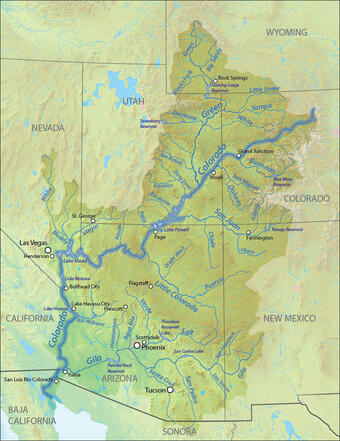Snowpack Sublimation - Measurements and Modeling in the Colorado River Basin Active
Snow is an essential resource in the western United States (U.S.), providing water for drinking, irrigation, industry, energy production, and ecosystems across much of the region. In the mountains of the western U.S., most precipitation falls as snow, which accumulates in seasonal snowpacks that serve as a large natural reservoir.
Snowpack sublimation, which is analogous to evaporation from land or water bodies, represents an important, but poorly quantified, loss of water from the snowpack. Sublimation is one the major uncertainties in runoff forecast models, and is thought to be particularly important during drought years, when water is scarce.

The map on the left shows the Colorado River Basin (CRB). On average, 70 to 85% of annual runoff in the Colorado River Basin originates as mountain snowmelt, which is a critical water supply for Denver, Las Vegas, Phoenix, Tucson, Los Angeles, and San Diego.
The U.S. Geological Survey (USGS) is conducting a study of snowpack sublimation in the CRB as part of the USGS National Water Census program.
The primary goal is to develop sublimation estimates for the CRB using ground-based measurements and moderate-resolution and high-resolution gridded models to inform hydrologic modeling studies, water availability studies, and water use assessments.
The USGS measured meteorological parameters at three sites in the Colorado River Basin near Snow Mountain Ranch, Colorado
Below are other science projects associated with this project.
Rocky Mountain Regional Snowpack Chemistry Monitoring Study
Water, Energy, and Biogeochemical Budgets (WEBB): Loch Vale Watershed
SnowModel simulations and supporting observations for the Rio Grande Headwaters, southwestern Colorado, United States, 1984 - 2017
SnowModel simulations and supporting observations for the north-central Colorado Rocky Mountains during water years 2011 through 2015
The USGS is measuring meteorological parameters at three sites in the Colorado River Basin
Below are links to plots of realtime weather data at 3 sites.
Below are publications associated with this project.
Snow sublimation in mountain environments and its sensitivity to forest disturbance and climate warming
- Overview
Snow is an essential resource in the western United States (U.S.), providing water for drinking, irrigation, industry, energy production, and ecosystems across much of the region. In the mountains of the western U.S., most precipitation falls as snow, which accumulates in seasonal snowpacks that serve as a large natural reservoir.
Snowpack sublimation, which is analogous to evaporation from land or water bodies, represents an important, but poorly quantified, loss of water from the snowpack. Sublimation is one the major uncertainties in runoff forecast models, and is thought to be particularly important during drought years, when water is scarce.
 Sources/Usage: Public Domain. View Media Details
Sources/Usage: Public Domain. View Media DetailsColorado River Basin Map The map on the left shows the Colorado River Basin (CRB). On average, 70 to 85% of annual runoff in the Colorado River Basin originates as mountain snowmelt, which is a critical water supply for Denver, Las Vegas, Phoenix, Tucson, Los Angeles, and San Diego.
The U.S. Geological Survey (USGS) is conducting a study of snowpack sublimation in the CRB as part of the USGS National Water Census program.
The primary goal is to develop sublimation estimates for the CRB using ground-based measurements and moderate-resolution and high-resolution gridded models to inform hydrologic modeling studies, water availability studies, and water use assessments.
The USGS measured meteorological parameters at three sites in the Colorado River Basin near Snow Mountain Ranch, Colorado
- Science
Below are other science projects associated with this project.
Rocky Mountain Regional Snowpack Chemistry Monitoring Study
Snowpacks collect atmospheric deposition throughout the snowfall season and offer a unique opportunity to obtain a composite sample of the chemistry of most of the annual precipitation at high elevations [> 1,800 meters]. The purpose of the snowpack network is to determine annual concentrations and depositional amounts of selected nutrients and other constituents in snow resulting from atmospheric...Water, Energy, and Biogeochemical Budgets (WEBB): Loch Vale Watershed
Loch Vale is an alpine/subalpine watershed in Rocky Mountain National Park where the U.S. Geological Survey has been conducting research since the 1980s. Our research has focused on the effects of climate change and atmospheric pollutants on water, soil, vegetation, and aquatic life. The alpine/subalpine ecosystem in Loch Vale is sensitive to changes in climate and air pollution. Our long-term... - Data
SnowModel simulations and supporting observations for the Rio Grande Headwaters, southwestern Colorado, United States, 1984 - 2017
This data release supports the study by Sexstone and others (2020) and contains simulation output from SnowModel (Liston and Elder, 2006), a well-validated process-based snow modeling system. Simulations are for water years 1984 through 2017 (October 1, 1983 through September 30, 2017) across a 11,200 square kilometer model domain in the San Juan Mountains of southwestern Colorado, United States tSnowModel simulations and supporting observations for the north-central Colorado Rocky Mountains during water years 2011 through 2015
This data release includes simulation output from SnowModel (Liston and Elder, 2006), a well-validated process-based snow modeling system, and supporting snow, meteorological, and streamflow observations from the water years 2011 through 2015 (October 1, 2010, through September 30, 2015) across a 3,600 square kilometer model domain in the north-central Colorado Rocky Mountains. For each water year - Multimedia
The USGS is measuring meteorological parameters at three sites in the Colorado River Basin
Below are links to plots of realtime weather data at 3 sites.
- Publications
Below are publications associated with this project.
Snow sublimation in mountain environments and its sensitivity to forest disturbance and climate warming
Snow sublimation is an important component of the snow mass balance, but the spatial and temporal variability of this process is not well understood in mountain environments. This study combines a process‐based snow model (SnowModel) with eddy covariance (EC) measurements to investigate (1) the spatio‐temporal variability of simulated snow sublimation with respect to station observations, (2) theAuthorsGraham A. Sexstone, David W. Clow, Steven R. Fassnacht, Glen E. Liston, Christopher A. Hiemstra, John F. Knowles, Colin A. Penn



